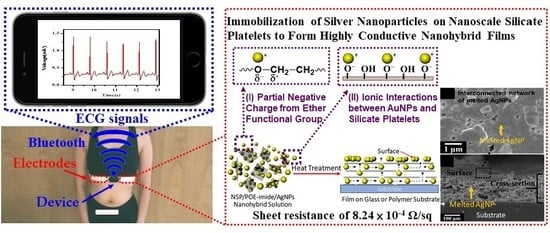Facile Fabrication of Flexible Electrodes and Immobilization of Silver Nanoparticles on Nanoscale Silicate Platelets to Form Highly Conductive Nanohybrid Films for Wearable Electronic Devices
Abstract
1. Introduction
2. Materials and Methods
2.1. Reagents and Chemicals
2.2. Direct Exfoliation of Layered Na+-MMT Clay into Nanoscale Silicate Platelets in Water Suspension
2.3. Synthesis of the Poly(oxyethelene)-Segmented Amide–Imide
2.4. Preparation of NSP/POE-Imide/AgNP Nanohybrid Suspensions
2.5. Preparation of NSP/POE-Imide/AgNP Nanohybrid Films
2.6. Instrumental Characterization
3. Results and Discussion
3.1. Synthesis of NSP/POE-Imide/AgNP Nanohybrid Suspensions
3.2. Facile Fabrication of the Highly Conductive NSP/POE-Imide/AgNPs Nanohybrid Films
3.3. Observation of Interconnected Network of Melted AgNPs via FE-SEM
3.4. Measurements of ECG Signals
4. Conclusions
Supplementary Materials
Author Contributions
Funding
Conflicts of Interest
References
- An, B.W.; Shin, J.H.; Kim, S.Y.; Kim, J.; Ji, S.; Park, J.; Lee, Y.; Jang, J.; Park, Y.G.; Cho, E.; et al. Smart sensor systems for wearable electronic devices. Polymers 2017, 9, 303. [Google Scholar] [CrossRef] [PubMed]
- Pandian, P.S.; Mohanavelu, K.; Safeer, K.P.; Kotresh, T.M.; Shakunthala, D.T.; Gopal, P.; Padaki, V.C. Smart vest: Wearable multi-parameter remote physiological monitoring system. Med. Eng. Phys. 2008, 30, 466–477. [Google Scholar] [CrossRef] [PubMed]
- Celik, N.; Manivannan, N.; Strudwick, A.; Balanchendran, W. Graphene-enabled electrodes for electrocardiogram monitoring. Nanomaterials 2016, 6, 156. [Google Scholar] [CrossRef] [PubMed]
- Mcsharry, P.E.; Clifford, G.D.; Tarassenko, L.; Smith, L.A. A dynamical model for generating synthetic electrocardiogram signals. IEEE Trans. Biomed. Eng. 2003, 5, 289–294. [Google Scholar] [CrossRef] [PubMed]
- Lee, S.; Shin, S.; Lee, S.; Seo, J.; Son, S.; Cho, H.J.; Algadi, H.; Al-Sayari, S.; Kim, D.E.; Lee, T. Ag nanowire reinforced highly stretchable conductive fibers for wearable electronics. Adv. Funct. Mater. 2015, 25, 3114–3121. [Google Scholar] [CrossRef]
- Dong, S.; Han, B.; Ou, J.; Li, Z.; Han, L.; Yu, X. Electrically conductive behaviors and mechanisms of short-cut super-fine stainless wire reinforced reactive powder concrete. Cem. Concr. Compos. 2016, 720, 48–65. [Google Scholar] [CrossRef]
- Wei, D.; Cotton, D.; Ryhanen, T. All-solid-state textile batteries made from nano-emulsion conducting polymer inks for wearable electronics. Nanomaterials 2012, 2, 268–274. [Google Scholar] [CrossRef]
- Jost, K.; Stenger, D.; Perez, C.R.; Mcdonough, J.K.; Lian, K.; Gogotsi, Y.; Dion, G. Knitted and screen printed carbon-fiber supercapacitors for applications in wearable electronics. Energy Environ. Sci. 2013, 6, 2698–2705. [Google Scholar] [CrossRef]
- Su, M.; Li, F.; Chen, S.; Huang, Z.; Qin, M.; Li, W.; Zhang, X.; Song, Y. Nanoparticle based curve arrays for multirecognition flexible electronics. Adv. Mater. 2015, 28, 1369–1374. [Google Scholar] [CrossRef]
- Faupel, F.; Zaporojtchenko, V.; Strunskus, T.; Elbahri, M. Metal-polymer nanocomposites for functional applications. Adv. Eng. Mater. 2010, 12, 1177–1190. [Google Scholar] [CrossRef]
- Vojtech, L.; Bortel, R.; Neruda, M.; Kozak, M. Wearable textile electrodes for ECG measurement. Adv. Electr. Electron. Eng. 2013, 11, 410–414. [Google Scholar] [CrossRef]
- Kumar, P.; Gusain, M.; Nagarajan, R. Synthesis of Cu1.8S and CuS from copper-thiourea containing precursors; anionic (ClP−, NO3−, SO4P2−P) influence on the product stoichiometry. Inorg. Chem. 2011, 50, 3065–3070. [Google Scholar] [CrossRef] [PubMed]
- Magdassi, S.; Grouchko, M.; Kamyshny, A. Copper nanoparticles for printed electronics: Routes towards achieving oxidation stability. Materials 2010, 3, 4626–4638. [Google Scholar] [CrossRef] [PubMed]
- Tursunkulov, O.; Allabergenov, B.; Abidov, A.; Jeong, S.W.; Kim, S. Synthesis, characterization and functionalization of the coated iron oxide nanostructures. J. Korean Powd. Met. Inst. 2013, 20, 180. [Google Scholar] [CrossRef]
- Deng, J.; He, C.L.; Peng, Y.; Wang, J.; Long, X.; Li, P.; Chan, A.S.C. Magnetic and conductive Fe3O4− polyaniline nanoparticles with core–shell structure. Synth. Met. 2003, 139, 295–301. [Google Scholar] [CrossRef]
- Chiu, C.W.; Ou, G.B.; Tsai, Y.H.; Lin, J.J. Immobilization of silver nanoparticles on exfoliated mica nanosheets to form highly conductive nanohybrid films. Nanotechnology 2015, 26, 465702. [Google Scholar] [CrossRef]
- Wang, S.; He, M.; Weng, B.; Gan, L.; Zhao, Y.; Xie, Y. Stretchable and wearable triboelectric nanogenerator based on kinesio tape for self-powered human motion sensing. Nanomaterials 2018, 8, 657. [Google Scholar] [CrossRef]
- Chiu, C.W.; Lin, C.A.; Hong, P.D. Melt-Spinning and thermal stability behaviour of TiO2 nanoparticle/polypropylene nanocomposite fibers. J. Polym. Res. 2011, 18, 367–372. [Google Scholar] [CrossRef]
- Zhang, X.F.; Liu, Z.G.; Shen, W.; Gurunathan, S. Silver nanoparticles: Synthesis, characterization, properties, applications, and therapeutic approaches. Int. J. Mol. Sci. 2016, 17, 1534. [Google Scholar] [CrossRef]
- Kholoud, M.M.; Abou, E.N.; Ala, E.; Abdulrhman, A.W. Synthesis and applications of silver nanoparticles. Arabian J. Chem. 2010, 3, 135–140. [Google Scholar]
- Chiu, C.W.; Ou, G.B. Facile preparation of highly electrically conductive films of silver nanoparticles finely dispersed in polyisobutylene-b-poly(oxyethylene)-b-polyisobutylene triblock copolymers and graphene oxide hybrid surfactants. RSC Adv. 2015, 5, 102462–102468. [Google Scholar] [CrossRef]
- Dong, R.X.; Liu, C.T.; Huang, K.C.; Chiu, W.Y.; Ho, K.C.; Lin, J.J. Controlling formation of silver/carbon nanotube networks for highly conductive film surface. ACS Appl. Mater. Interfaces 2012, 4, 1449–1455. [Google Scholar] [CrossRef] [PubMed]
- Woo, K.; Kim, D.; Kim, J.S.; Lim, S.; Moon, J. Ink-jet printing of Cu−Ag-based highly conductive tracks on a transparent substrate. Langmuir 2009, 25, 429–433. [Google Scholar] [CrossRef] [PubMed]
- Jiang, H.; Moon, K.S.; Hua, F.; Wong, C.P. Synthesis and thermal and wetting properties of tin/silver alloy nanoparticles for low melting point lead-free solders. Chem. Mater. 2007, 19, 4482–4485. [Google Scholar] [CrossRef]
- Ma, P.C.; Tang, B.Z.; Kim, J.K. Effect of CNT decoration with silver nanoparticles on electrical conductivity of CNT-polymer composite. Carbon 2008, 46, 1497–1505. [Google Scholar] [CrossRef]
- Shibata, J.; Shimizu, K.I.; Takada, Y.; Shichi, A.; Yoshida, H.; Satokawa, S.; Satsuma, A.; Hattori, T. Structure of active Ag clusters in Ag zeolites for SCR of NO by propane in the presence of hydrogen. J. Catal. 2004, 227, 367–374. [Google Scholar] [CrossRef]
- Aihara, N.; Torigoe, K.; Esumi, K. Preparation and characterization of gold and silver nanoparticles in layered laponite suspensions. Langmuir 1998, 14, 4945–4949. [Google Scholar] [CrossRef]
- Liu, J.; Lee, J.B.; Kim, D.H.; Kim, Y. Preparation of high concentration of silver colloidal nanoparticles in layered laponite sol. Colloids Surf. A 2007, 302, 276–279. [Google Scholar] [CrossRef]
- Chiu, C.W.; Hong, P.D.; Lin, J.J. Clay-mediated synthesis of silver nanoparticles exhibiting low-temperature melting. Langmuir 2011, 27, 11690–11696. [Google Scholar] [CrossRef]
- Chiu, C.W.; Huang, T.K.; Wang, Y.C.; Alamani, B.G.; Lin, J.J. Intercalation strategies in clay/polymer hybrids. Prog. Polym. Sci. 2014, 39, 443–485. [Google Scholar] [CrossRef]
- Chiu, C.W.; Chu, C.C.; Dai, S.A.; Lin, J.J. Self-piling silicate rods and dendrites from high aspect-ratio clay platelets. J. Phys. Chem. C 2008, 112, 17940–17944. [Google Scholar] [CrossRef]
- Chiu, C.W.; Lin, J.J. Self-assembly behavior of polymer-assisted clay. Prog. Polym. Sci. 2012, 37, 406–444. [Google Scholar] [CrossRef]
- Koo, J.H.; Jeong, S.; Shim, H.J.; Son, D.; Kim, J.; Kim, D.C.; Choi, S.; Hong, J.I.; Kim, D.H. Wearable electrocardiogram monitor using carbon nanotube electronics and color-tunable organic light-emitting diodes. ACS Nano 2017, 11, 10032–10041. [Google Scholar] [CrossRef] [PubMed]
- Kim, H.W.; Kim, T.Y.; Park, H.K.; You, I.; Kwak, J.; Kim, J.C.; Hwang, H.; Kim, H.S.; Jeong, U. Hygroscopic auxetic on-skin sensors for easy-to-handle repeated daily use. ACS Appl. Mater. Interfaces 2018, 10, 40141–40148. [Google Scholar] [CrossRef] [PubMed]
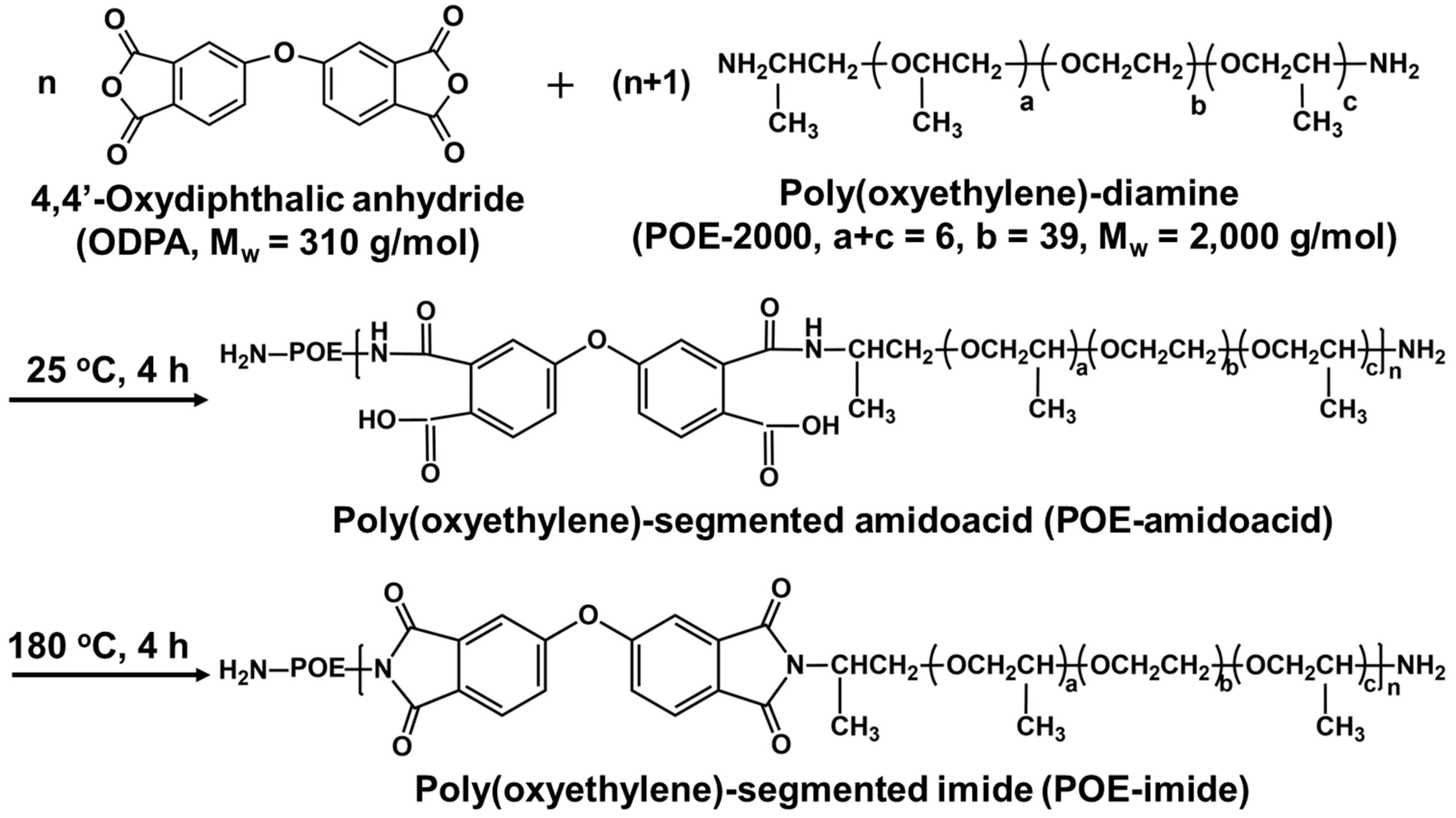
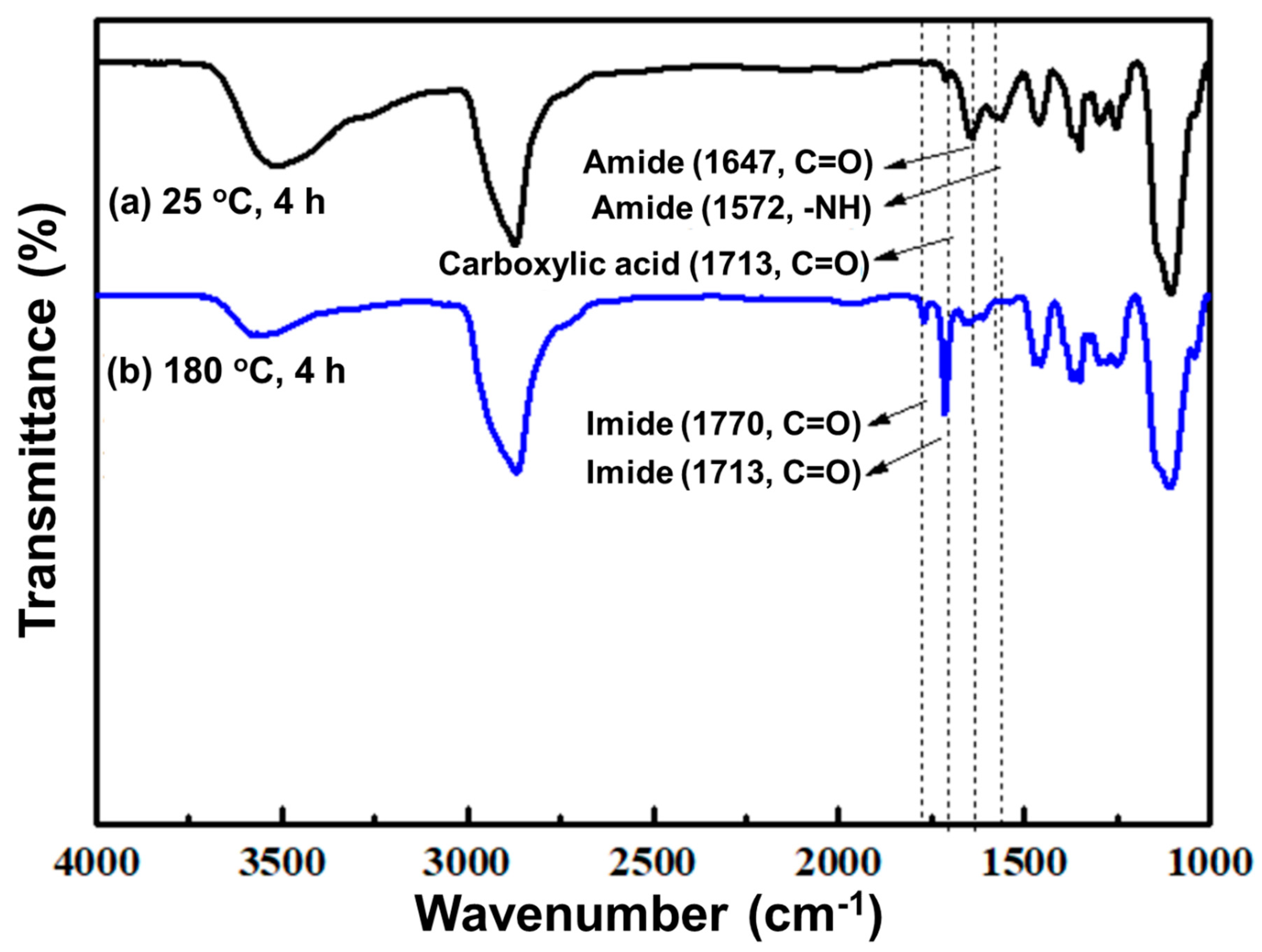
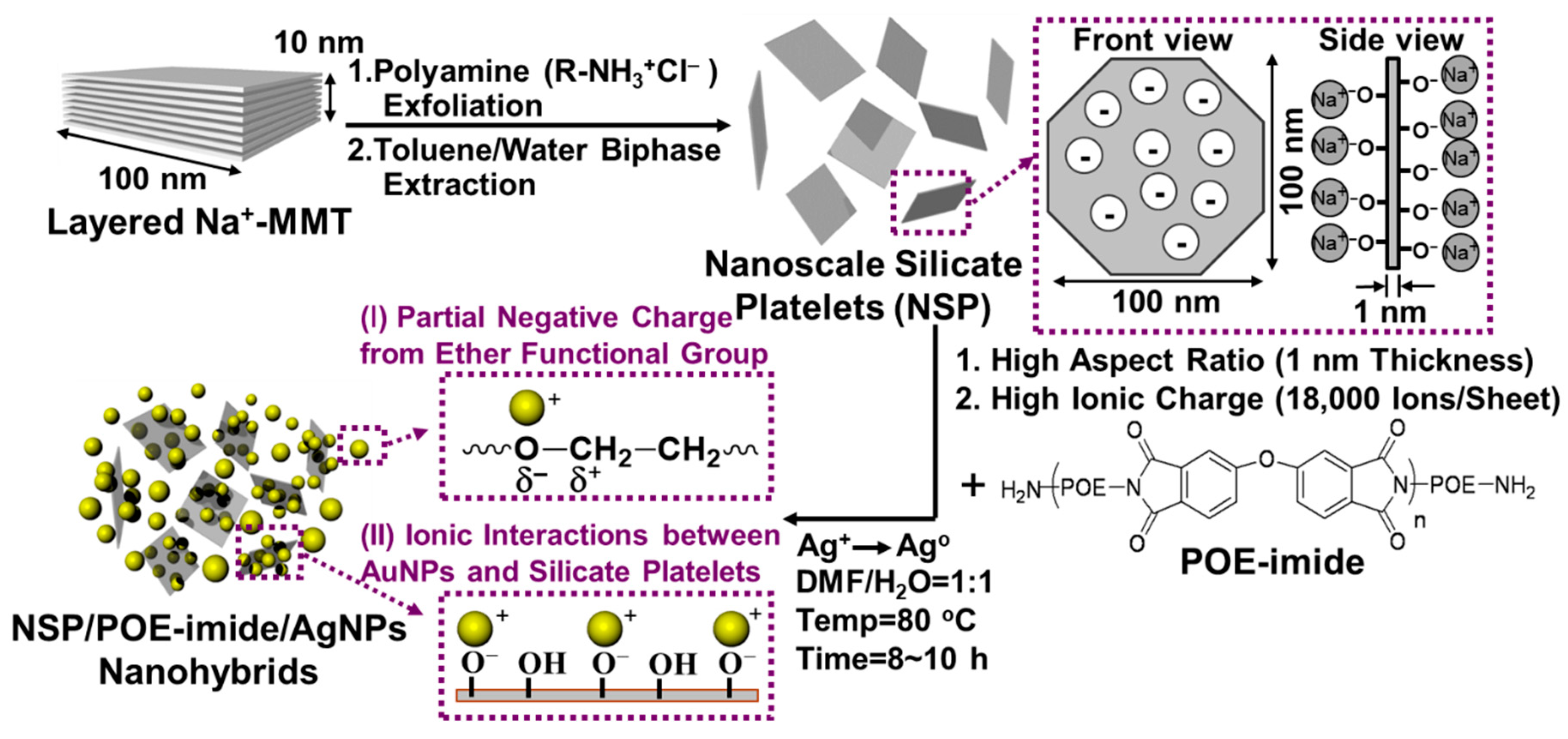
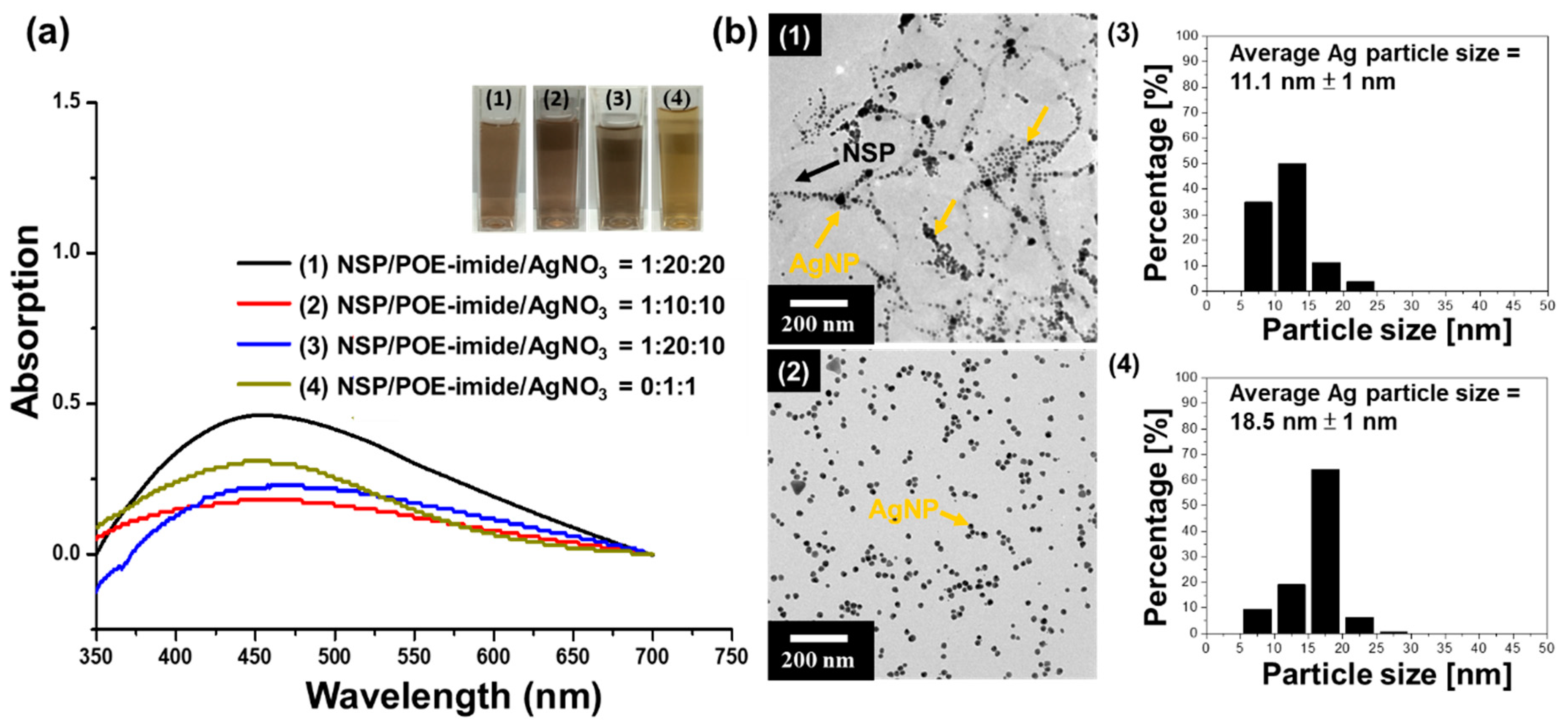
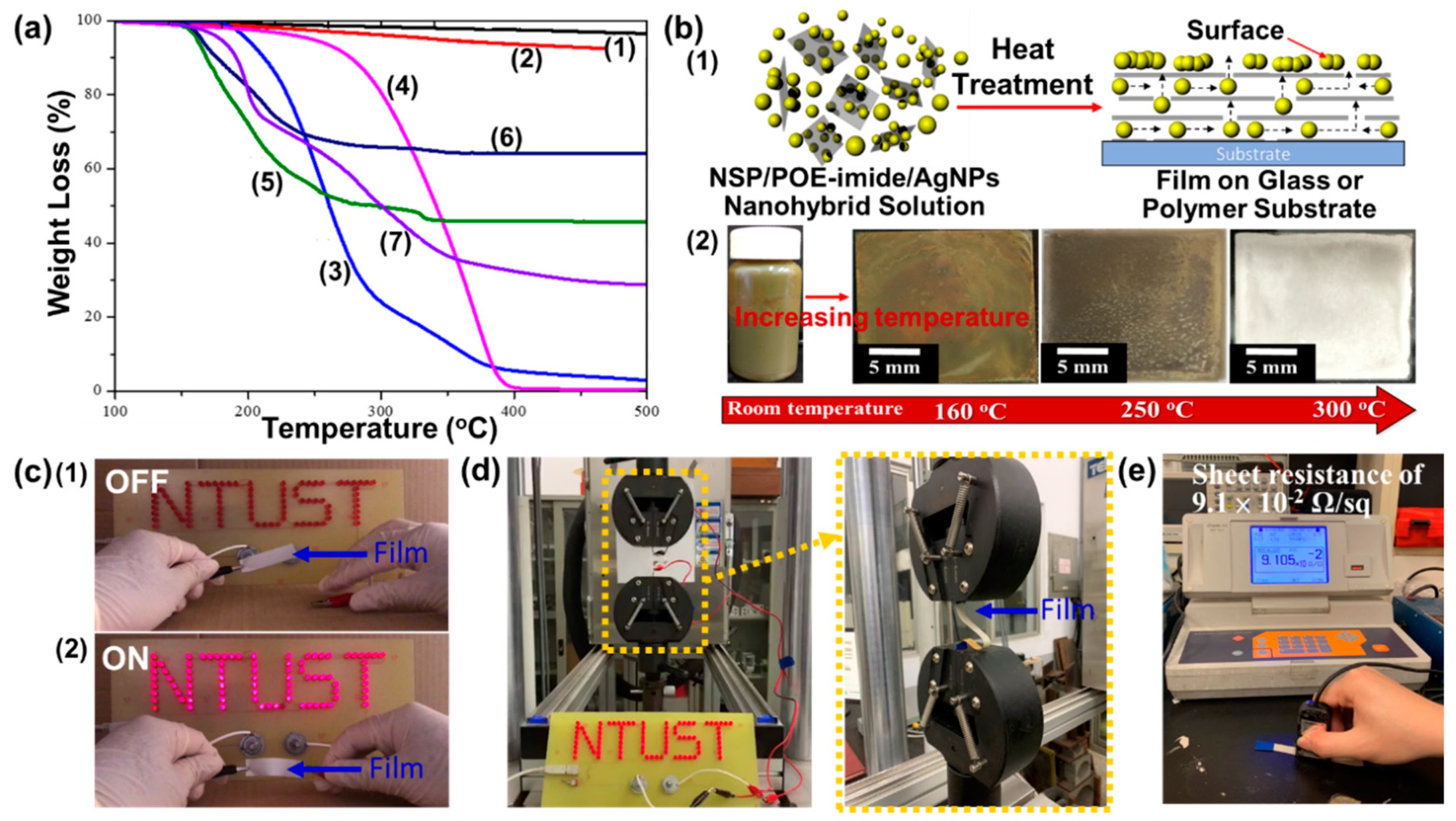
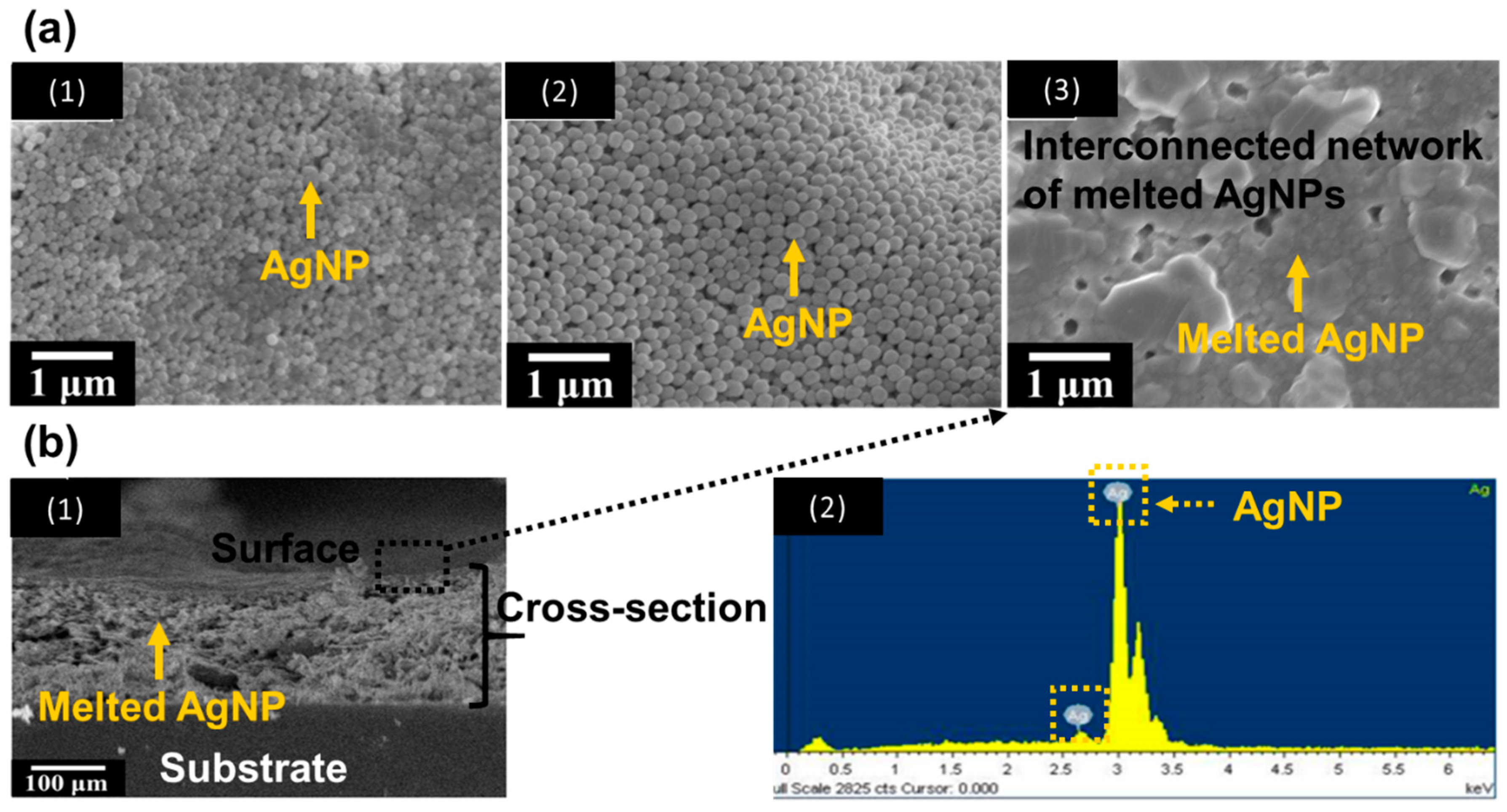
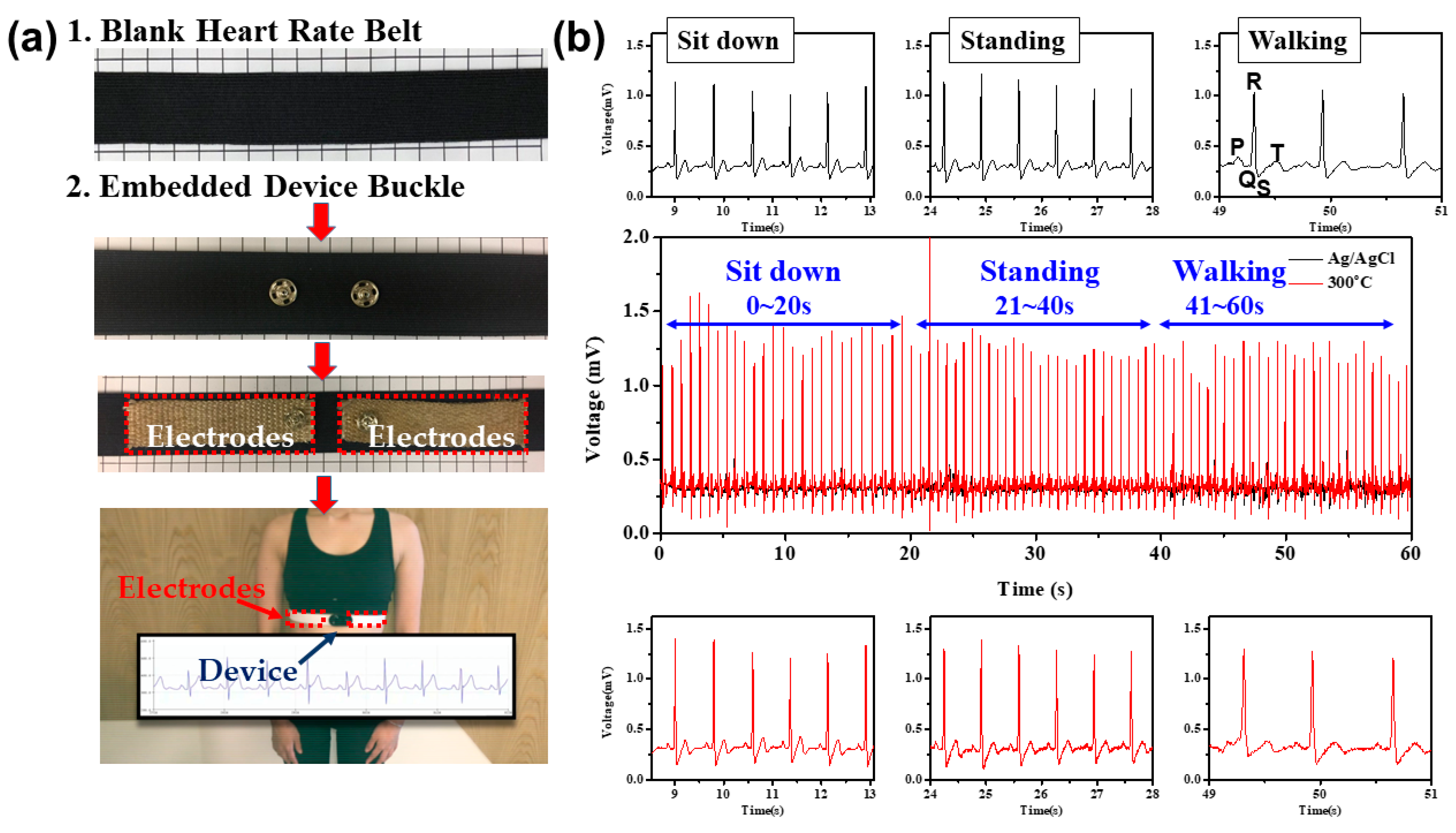
| Sample | Weight Fraction (w/w/w) | AgNP a (wt%) | Sheet Resistance (Ω/sq) b | ||
|---|---|---|---|---|---|
| 160 °C | 250 °C | 300 °C | |||
| NSP | -- | -- | -- | -- | 1.94 × 106 |
| POE-imide/AgNO3 | 1:1 | -- | -- | 1.45 × 10−1 | 2.68 × 10−2 |
| NSP/POE-imide/AgNO3 | 1:10:10 | 1 | 8.27 × 101 | 6.26 × 10−2 | 5.27 × 10−2 |
| 1:20:20 | 1 | 2.74 × 106 | 2.34 × 103 | 5.32 × 10−2 | |
| 1:10:20 | 1 | -- | 4.45 × 10−2 | 5.56 × 10−2 | |
| 1:10:35 | 5 | 2.76 × 103 | 4.12 × 10−4 | 8.24 × 10−4 | |
© 2019 by the authors. Licensee MDPI, Basel, Switzerland. This article is an open access article distributed under the terms and conditions of the Creative Commons Attribution (CC BY) license (http://creativecommons.org/licenses/by/4.0/).
Share and Cite
Huang, P.-Y.; Chiu, C.-W.; Huang, C.-Y.; Shen, S.-Y.; Lee, Y.-C.; Cheng, C.-C.; Jeng, R.-J.; Lin, J.-J. Facile Fabrication of Flexible Electrodes and Immobilization of Silver Nanoparticles on Nanoscale Silicate Platelets to Form Highly Conductive Nanohybrid Films for Wearable Electronic Devices. Nanomaterials 2020, 10, 65. https://doi.org/10.3390/nano10010065
Huang P-Y, Chiu C-W, Huang C-Y, Shen S-Y, Lee Y-C, Cheng C-C, Jeng R-J, Lin J-J. Facile Fabrication of Flexible Electrodes and Immobilization of Silver Nanoparticles on Nanoscale Silicate Platelets to Form Highly Conductive Nanohybrid Films for Wearable Electronic Devices. Nanomaterials. 2020; 10(1):65. https://doi.org/10.3390/nano10010065
Chicago/Turabian StyleHuang, Peng-Yang, Chih-Wei Chiu, Chen-Yang Huang, Sheng-Yen Shen, Yen-Chen Lee, Chih-Chia Cheng, Ru-Jong Jeng, and Jiang-Jen Lin. 2020. "Facile Fabrication of Flexible Electrodes and Immobilization of Silver Nanoparticles on Nanoscale Silicate Platelets to Form Highly Conductive Nanohybrid Films for Wearable Electronic Devices" Nanomaterials 10, no. 1: 65. https://doi.org/10.3390/nano10010065
APA StyleHuang, P.-Y., Chiu, C.-W., Huang, C.-Y., Shen, S.-Y., Lee, Y.-C., Cheng, C.-C., Jeng, R.-J., & Lin, J.-J. (2020). Facile Fabrication of Flexible Electrodes and Immobilization of Silver Nanoparticles on Nanoscale Silicate Platelets to Form Highly Conductive Nanohybrid Films for Wearable Electronic Devices. Nanomaterials, 10(1), 65. https://doi.org/10.3390/nano10010065







